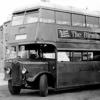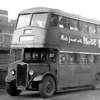Midland “Red” Motor Services (BMMO & MROC)
Guy Arab — Overview
Introduction
Guy Arab
Guy Motors started building buses when sales of their goods vehicles were suffering during the great depression of the 1920s, but by the end of the 1930s the company had still not made any major inroads into the marketplace and bus sales were poor. However, during the Second World War, when most manufacturing was turned over to the war effort, Guy were one of a small number of vehicle manufactures commissioned by the Ministry of War Transport to continue building buses.
Guy’s wartime buses were built on the company’s existing Arab chassis, and because of strict wartime rationing on building materials, most vehicles had bodywork built to a basic standardised wartime “utility” specification.
The Ministry of War Transport maintained strict control over vehicle production and allocation, and like many bus operators around the country, Birmingham and Midland Motor Omnibus Company Limited (BMMO—Midland “Red” Motor Services) had a number of Guy Arab buses imposed upon them during the war years. However, these vehicles proved to be well made and reliable, and Guy quickly gained a good reputation as a bus maker. As a result, many bus operators who’d had Guy Arabs forced upon them during the war, including BMMO, continued buying Guy vehicles once the war restrictions were lifted.
Page Content
Ministry of War Transport Allocations
R/Nos: GHA886–891
In early 1942, Birmingham and Midland Motor Omnibus Company Limited (BMMO—Midland “Red” Motor Services) had been assigned nine Leyand Titian and six AEC Regent double-deck buses from the Ministry of War Transport. These vehicles were built using pre-war parts that had been frozen earlier in the war, and were similar to the pre-war specification of the vehicles produced by those manufactures.
Towards the end of 1942, BMMO received their first six full “Utility” buses. These were built on the Guy Arab Mk.I chassis with 56-seat bodywork by Weymann built to wartime “Utility” specification, which restricted the use of alloys. The vehicles were registered GHA886–891, and from March 1944 they carried fleet numbers 2452–2457.
2497–2508 (R/Nos: GHA921–932)
In 1943, twelve additional vehicles were received from the Ministry of War Transport. Ten of these were built on the newer Guy Arab Mk.II chassis which has a longer bonnet and the radiator protruding past the cab. This feature was designed so the chassis could fit the larger Gardener 6LW engine, although all of the vehicles BMMO received had the smaller Gardener 5LW engines fitted.
The other two of the vehicles received in 1943, fleet numbers 2499 and 2500, were built on the Guy Arab Mk.I chassis. Unlike all the other Guy Arab buses acquired during the war, these two vehicles didn’t have “Utility” bodywork, but instead bodywork that had been intended for fitting to Daimler chassis before the war, and rendered redundant when Daimler production was suspended. The framework had been built by Metropolitan-Cammell Carriage and Wagon Company (“Metro-Cammell”) before the war, and later finished by Weymann. These two vehicles were only ever operated from Sutton Coldfield depot.
In 1943, production of Daimler bus chassis restarted and between 1943 and 1945, in addition the the Guy Arab vehicles, BMMO received 33 Daimler CWA6 double-deck buses with full “Utility” bodywork by Weymann, Duple or Brush.
2550–2578, 2580–2590 (R/Nos: HHA2–30, HHA57–62 & HHA81–85)
Forty more Guy Arab “Utility” buses were acquired during 1944 and 1945. All of these were built on the Guy Arab Mk.II chassis with Gardener 5LW engines, the same as the majority of the vehicles received in 1943, however, unlike the vehicles received in 1943, bodywork was no longer exclusively finished by Weymann. Fleet numbers 2570–2572 and 2580–2585 had bodywork by Park Royal, and these nine vehicles were only ever operated from Sutton Coldfield depot.
Fleet numbers 2586–2590 had bodywork by Northern Counties. This company had been granted a special dispensation by the Ministry of Supply to build their products to a relaxed specification, as they held large stocks of materials and few facilities for making wood framing, and therefore these vehicles featured more opening windows, smooth roofline and upholstered seats in place of the wooden slatted seats found on the other vehicles.
Post-war Refits
After the war, all of these vehicles were improved and refitted, with the first changes being to the wooden slatted seats which were replaced with upholstered ones on all “Utility” vehicles between November 1945 and October 1947.
Between 1949 and 1951, all of the vehicles with Weymann and Park Royal bodywork were rebuilt by Brush or in-house by BMMO at Central Works. At this time they received new front wings, rubber-mounted windows, sliding ventilators, rounded rear roof domes and new destination equipment. The Guy Arab Mk.II vehicles had their bonnets shortened to Mk.I specification, with panels added to the cabs to make them flush with the radiator.
Vehicles with Northern Counties bodywork did not require as much attention as these had been built to a better specification, but they still received renovation by Aero & Engineering (Merseyside) Limited of Hooton in 1951.
Post-war Vehicle Acquisitions: Type Code GD6
3557–3576 (R/Nos: MHA57–76)
Production of Birmingham and Midland Motor Omnibus Company Limited (BMMO—Midland “Red” Motor Services) vehicles had been suspended during the Second World War, with the only new vehicle acquisitions being the vehicles allocated to them by the Ministry of War Transport, such as the “Utility” Guy Arab buses described above. When BMMO vehicle production restarted in 1946, the company focused their attention on single-deck vehicles, with the plan for post-war double-deck acquisitions to come from outside manufactures. The first 100 post-war double-deck buses should have been type AD2 AEC Regents from late 1946, but these were hugly delayed and arrived between February 1948 and December 1950.
Production of BMMO double-deck vehicles finally restarted in 1949, with the BMMO D5, but new vehicles were still urgently needed and thus in April 1949, three months before the first BMMO D5 entered service, BMMO started to take delivery of a batch of twenty Guy Arab Mk.III double-deck buses, classed by BMMO as type code GD6.
These vehicles were fitted to 10.35 litre Meadows 6DC 630 engines, and bodywork was by Guy on Park Royal frames. Unlike other post-war vehicle allocations, the bodywork was not to BMMO’s own design and featured traditional exposed radiators and half-drop windows making them look old-fashioned when compared with other post-war vehicles in the BMMO fleet.
The Meadows engines were the largest available on the British market at the time, and were thus very powerful and strong performers. This made them ideal for use around the steep hills in the Dudley area, and all twenty vehicles were allocated Dudley depot. Unfortunately though, the Meadows engines were unreliable and complex to repair, and in 1952, BMMO experimented with fitted a Gardner 5LW and a BMMO ‘K’-series engine in two of these vehicles. At the end of these trials all twenty vehicles were refitted with BMMO ‘K’-series engines.
All twenty vehicles were withdrawn between November 1961 and December 1962, having served their entire lives at Dudley depot, although four examples did operate as Engineering Float vehicles for a few months towards the end of their lives.
Acquired with the Business of Kemp & Shaw
4838–4843 (R/Nos: DJF392, EBC882, EJF668–669, FJF89–90)
On 30th July 1955, Birmingham and Midland Motor Omnibus Company Limited (Midland “Red”) acquired the share capital of Kemp & Shaw Limited, Leicester, which included a fleet of seven Guy and two Leyland buses. For several years, this newly acquired company operated as a subsidiary of Midland “Red” and the vehicles retained Kemp and Shaw livery. However, on 1st January 1959, Kemp & Shaw was absorbed into the parent company and thus their remaining vehicles passed to the BMMO fleet, as detailed below.
- Fleet numbers 24–27 (DJF392, EBC882, EJF668–9)
Four Guy Arab Mk.III double-deck buses with H30/26R Northern Counties bodywork,
new between March 1946 and November 1947, passed to BMMO as fleet numbers 4838–4841. - Fleet numbers 28 & 29 (FJF89–90)
Two Guy Arab Mk.III single-deck buses with B35F Barnard bodywork,
new in April 1949, passed to BMMO as fleet numbers 4842 & 4843.
Although not strictly relevant to this section of the website but shown here for completeness, BMMO also acquired two Leyland Titan double-deck buses from the Kemp & Shaw fleet at this time.
- Fleet number 30 (GRY763)
Leyland PD2/1 double-deck bus with lowbridge L27/26RD Leyland bodywork,
new in July 1950, passed to BMMO as fleet number 4844. - Fleet number 31 (JBC989)
Leyland PD2/12 double-deck bus with H30/26RD Leyland bodywork,
new in December 1952, passed to BMMO with fleet number 4845.
All eight vehicles entered service with BMMO on 1st January 1959 at Sandacre Street depot, Leicester, and soon gained BMMO livery. The four Guy Arab double-deck buses were all withdrawn in December 1960 and January 1961, but two examples, fleet numbers 4838 and 4841, found further service as driver training vehicles until April 1961. The two Guy Arab single-deck buses both saw service at other depots until they were withdrawn in March and April 1962 and sold to other operators.










